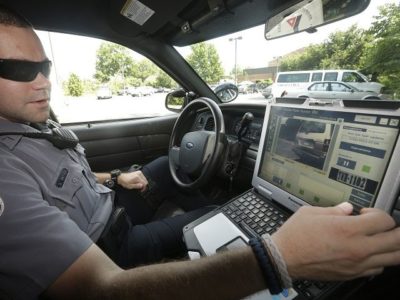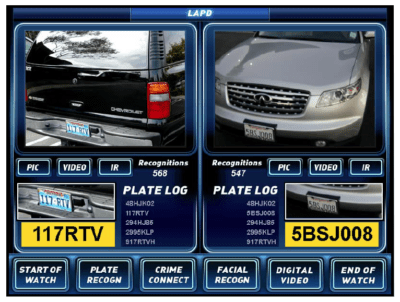
![]() The United States Immigration and Customs Enforcement (ICE) agency recently signed a contract with private company Vigilant Solutions to officially secure agency-wide access to its massive nationwide license plate recognition database, according to a new report byThe Verge. The database contains billions of license plate records and over 2 billion license plate reader (LPR) photos collected from local law enforcement agencies and camera-equipped police cars, plus numerous commercial points like tollbooths, vehicle repossession agencies, and other private groups. These visual data sources feed over 100 million new records each month into the database. Each entry is tagged with the date, time, and GPS location coordinates of the sighting.
The United States Immigration and Customs Enforcement (ICE) agency recently signed a contract with private company Vigilant Solutions to officially secure agency-wide access to its massive nationwide license plate recognition database, according to a new report byThe Verge. The database contains billions of license plate records and over 2 billion license plate reader (LPR) photos collected from local law enforcement agencies and camera-equipped police cars, plus numerous commercial points like tollbooths, vehicle repossession agencies, and other private groups. These visual data sources feed over 100 million new records each month into the database. Each entry is tagged with the date, time, and GPS location coordinates of the sighting.
Vigilant, the leading network for license plate recognition data in the U.S., boasts that it “can offer over 5 billion nationwide detections and over 150 million more added monthly” to entities that sign up for the service. The recently-established contract enables every ICE office to search five years of historical sightings or be notified in real-time of new sightings for a particular license plate.
 With access to the massive vehicle-tracking network, an agent searching the database for a certain plate will be able to track the correlating vehicle’s movements over the course of five years, as well as find an individual’s residences. They would also be able to configure and receive instant notifications whenever a new record of a selected plate is loaded into the system — a system known internally as a “hot list.” The same alerts can also be funneled to Vigilant’s iOS app.
With access to the massive vehicle-tracking network, an agent searching the database for a certain plate will be able to track the correlating vehicle’s movements over the course of five years, as well as find an individual’s residences. They would also be able to configure and receive instant notifications whenever a new record of a selected plate is loaded into the system — a system known internally as a “hot list.” The same alerts can also be funneled to Vigilant’s iOS app.
According to an official privacy assessment, up to 2,500 license plates could be uploaded to the hot list in a single batch, although the assessment does not specify how often new batches can be added. With sightings constantly pouring in from police dashcams and stationary readers on bridges and toll booths all over the nation, it would be difficult for anyone on the list to drive around unnoticed for long.
 A historical search would fetch from the database every place a selected license plate has made a recorded appearance in the last five years, generating a detailed record of the target’s movements. That data could be used to find a given subject’s residence or even identify associates if a given car is regularly spotted in a specific parking lot.
A historical search would fetch from the database every place a selected license plate has made a recorded appearance in the last five years, generating a detailed record of the target’s movements. That data could be used to find a given subject’s residence or even identify associates if a given car is regularly spotted in a specific parking lot.
“Knowing the previous locations of a vehicle can help determine the whereabouts of subjects of criminal investigations or priority aliens to facilitate their interdiction and removal,” the privacy assessment explains.
“In some cases, when other leads have gone cold, the availability of commercial LPR data may be the only viable way to find a subject.”
 The new LPR service contract was achieved after years of internal lobbying efforts by the agency. ICE first tested Vigilant’s system in 2012 to gauge how effective it was at locating undocumented immigrants. Two years later, the agency issued an open solicitation for the technology, sparking outcries from civil liberties groups. Department of Homeland Security Secretary Jeh Johnson canceled the solicitation shortly thereafter in response, citing privacy concerns, although two ICE field offices subsequently established rogue contracts with Vigilant regardless, in apparent blatant violation of Johnson’s directive. In 2015, the DHS issued another call for bids, but no contract resulted from that solicitation, according to an ICE representative.
The new LPR service contract was achieved after years of internal lobbying efforts by the agency. ICE first tested Vigilant’s system in 2012 to gauge how effective it was at locating undocumented immigrants. Two years later, the agency issued an open solicitation for the technology, sparking outcries from civil liberties groups. Department of Homeland Security Secretary Jeh Johnson canceled the solicitation shortly thereafter in response, citing privacy concerns, although two ICE field offices subsequently established rogue contracts with Vigilant regardless, in apparent blatant violation of Johnson’s directive. In 2015, the DHS issued another call for bids, but no contract resulted from that solicitation, according to an ICE representative.
Consequently, this is the first agency-wide contract ICE has completed with Vigilant Solutions; this landmark is reflected in accompanying documents. On December 27th, 2017, Homeland Security issued an updated privacy assessment of license plate reader technology, a move it explained was necessary because “ICE has now entered into a contract with a vendor.”
 The new system places some limits on ICE surveillance, but not enough to quell privacy concerns. Unlike many agencies, ICE will not be uploading new data to Vigilant’s collection; it will simply search through the existing data. Hence, driving past a Vigilant-linked camera might flag a car to ICE, but driving past an ICE camera won’t flag a car to everyone else using Vigilant’s system. License plates on the “hot list” will also expire and drop off after one year, and the system retains extensive audit logs to help network supervisors trace back any abuse of the system.
The new system places some limits on ICE surveillance, but not enough to quell privacy concerns. Unlike many agencies, ICE will not be uploading new data to Vigilant’s collection; it will simply search through the existing data. Hence, driving past a Vigilant-linked camera might flag a car to ICE, but driving past an ICE camera won’t flag a car to everyone else using Vigilant’s system. License plates on the “hot list” will also expire and drop off after one year, and the system retains extensive audit logs to help network supervisors trace back any abuse of the system.
Dani Bennett, a spokesperson for ICE, said in an agency statement:
“Like most other law enforcement agencies, ICE uses information obtained from license plate readers as one tool in support of its investigations. ICE conducts both criminal investigations and civil immigration enforcement investigations. ICE is not seeking to build a license plate reader database, and will not collect nor contribute any data to a national public or private database through this contract.”
 The agency claims it will not upload any photos it obtains into the system, and will only be able to search through the records as part of their on-going immigrations investigations.
The agency claims it will not upload any photos it obtains into the system, and will only be able to search through the records as part of their on-going immigrations investigations.
For privacy activists and civil liberties groups, however, the implications stretch far beyond simply immigration. “There are people circulating in our society who are undocumented,” says senior policy analyst Jay Stanley, who studies license plate readers with the ACLU.
“Are we as a society, out of our desire to find those people, willing to let our government create an infrastructure that will track all of us?”
Still, the biggest concern for critics is the sheer scale of Vigilant’s network, assembled almost entirely outside of public accountability. “If ICE were to propose a system that would do what Vigilant does, there would be a huge privacy uproar and I don’t think Congress would approve it,” Stanley says. “But because it’s a private contract, they can sidestep that process.”
These highly intrusive capabilities are particularly troubling given ICE’s recent actions to expand deportations beyond criminal offenders, fueling concerns of politically motivated enforcement. The Verge highlighted key examples of such movement within states:
In California, state officials have braced for rumored deportation sweeps targeting sanctuary cities. In New York, community leaders claim they’ve been specifically targeted for deportation as a result of their activism. With automated license plate recognition, that targeting would only grow more powerful.
 Using this technology, ICE and DHS could hypothetically track everywhere an individual’s car has been spotted in the past 5 years to establish patterns based off of information collected from patrol cars, toll booths, and other visual data points. This practice is a predatory and possibly unconstitutional violation of privacy. But in a post-9/11 world, the very notion of ICE implementing a vast, nationwide infrastructure for real-time physical location tracking in addition to the National Security Agency (NSA)‘s mass surveillance and bulk collection of digital communications — whose authorization has just been renewed by Congress for another 6 years — has somehow become acceptable and uncontroversial in this current Orwellian militarized police surveillance state.
Using this technology, ICE and DHS could hypothetically track everywhere an individual’s car has been spotted in the past 5 years to establish patterns based off of information collected from patrol cars, toll booths, and other visual data points. This practice is a predatory and possibly unconstitutional violation of privacy. But in a post-9/11 world, the very notion of ICE implementing a vast, nationwide infrastructure for real-time physical location tracking in addition to the National Security Agency (NSA)‘s mass surveillance and bulk collection of digital communications — whose authorization has just been renewed by Congress for another 6 years — has somehow become acceptable and uncontroversial in this current Orwellian militarized police surveillance state.
ICE’s unwarranted tracking of people’s cars and vehicular movements does more than just violate a person’s privacy. By creating this entirely new form of surveillance through a contract with a private entity, ICE has expanded its authority and scope without any sort of public accountability or oversight, and without any form of Congressional or other legislative approval. This stark power grab neatly sidesteps the significant checks and balances at the fundamental heart of the limited government concept to prevent it from descending into tyranny.
[whohit]ice-now-tracking-license-plates-across-country[/whohit]

Leave a comment: